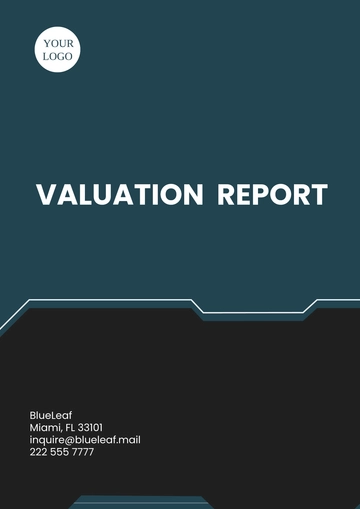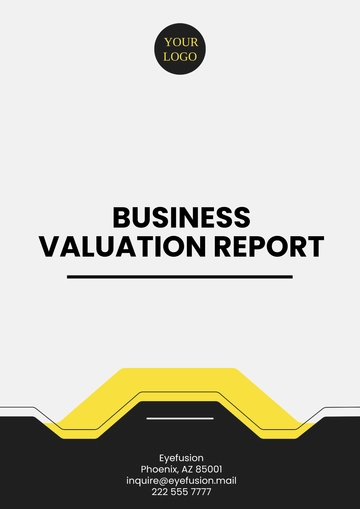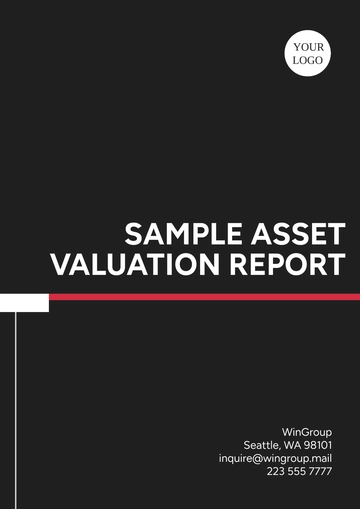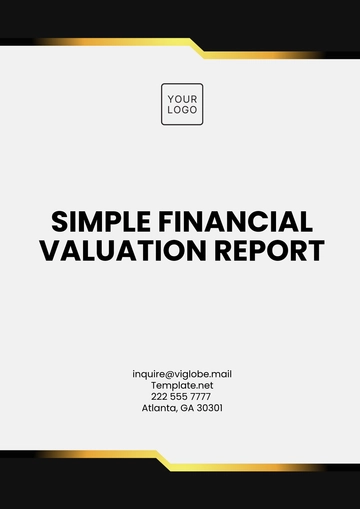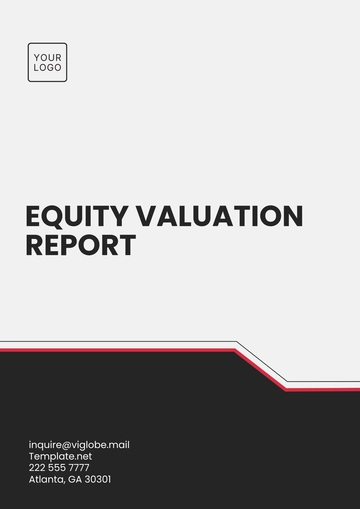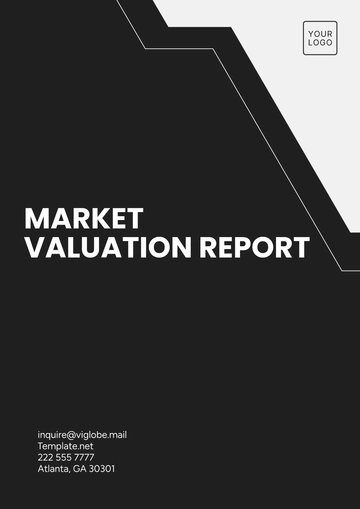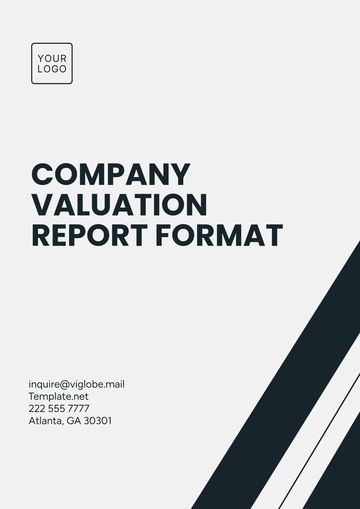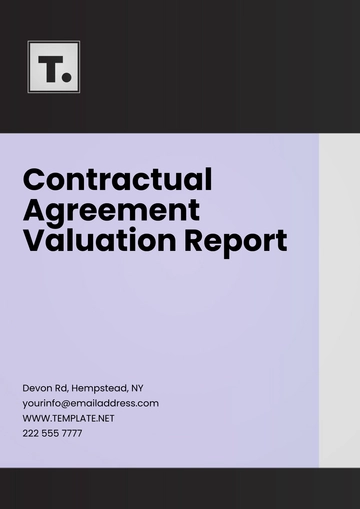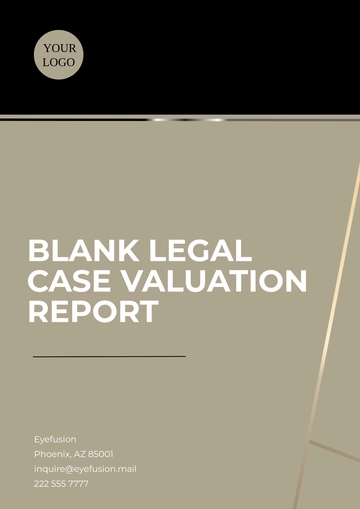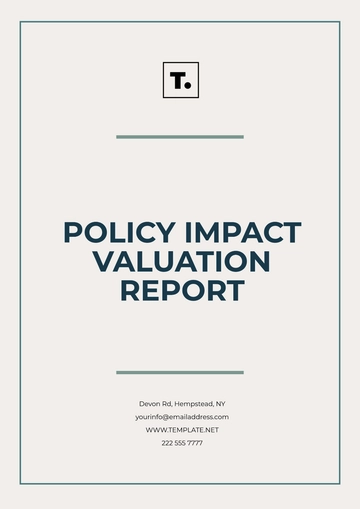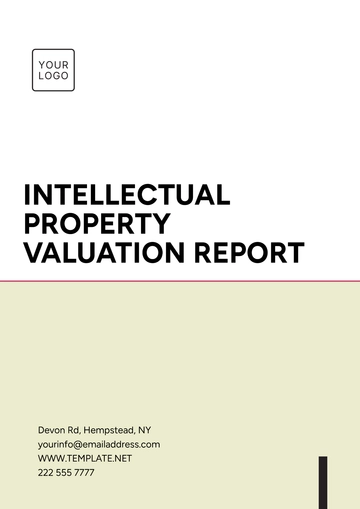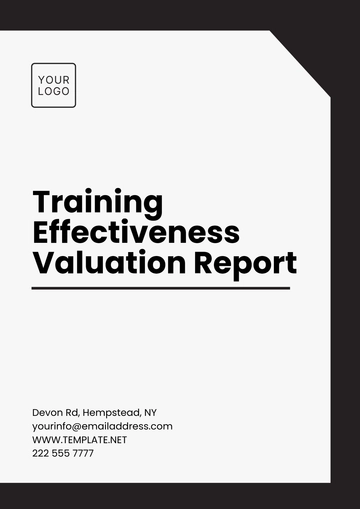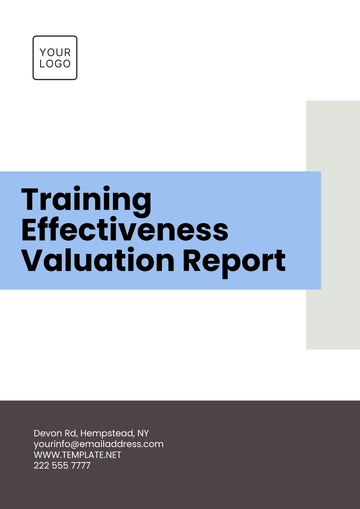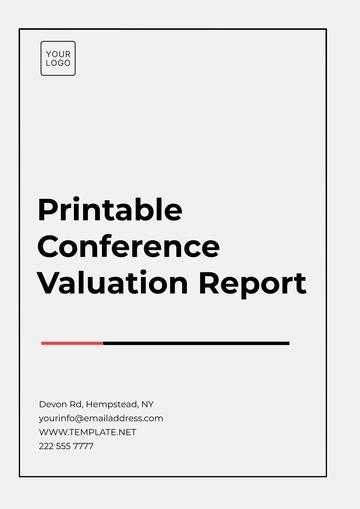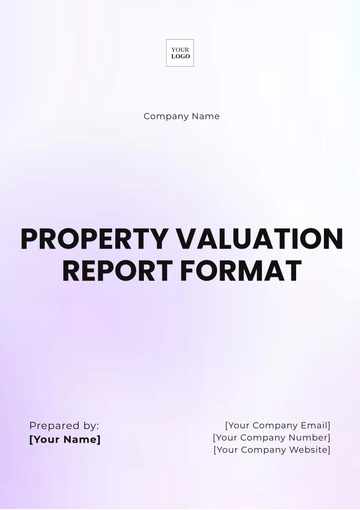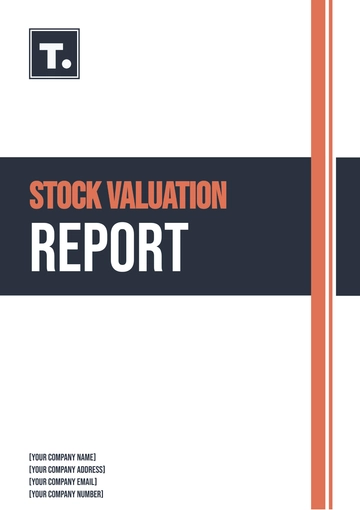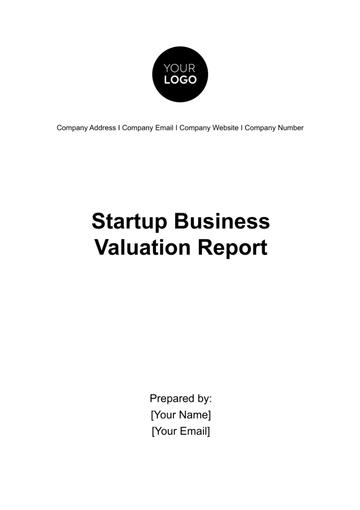Free Startup Business Valuation Report

Executive Summary
This report presents an in-depth valuation of our startup as of [Date], providing key insights into our financial status, market position, and future growth prospects. Operating within the technology sector, specifically in software development for small and medium-sized enterprises (SMEs), our startup has emerged as a leader in creating innovative solutions that drive efficiency and productivity for our clients. The valuation has been conducted to guide strategic decisions, attract potential investments, and provide our stakeholders with a clear understanding of the company's value.
Key Findings
Revenue growth of 35% year-over-year for the past three years, reaching $5 million in the last fiscal year.
Discounted Cash Flow (DCF) valuation estimates the company's value at approximately $25 million, reflecting our robust future cash flow potential.
Comparable Company Analysis (CCA) suggests a market valuation range of $22 million to $30 million, in line with industry standards.
Anticipated market demand growth for our products/services at a Compound Annual Growth Rate (CAGR) of 20% over the next five years.
Given these findings, we recommend focusing on expanding our market presence and exploring strategic partnerships to leverage industry trends. Additionally, initiating a Series B funding round could accelerate our growth initiatives and solidify our market positioning.
I. Purpose of the Valuation
The valuation is undertaken to accurately determine our startup's current market value, aiding in strategic decision-making processes related to potential equity financing, mergers and acquisitions, and partnership opportunities. It also aims to enhance transparency for current and prospective investors by providing a detailed analysis of our financial health and growth trajectory.
II. Scope of the Report
This report encompasses a thorough analysis spanning from historical financial performance to projections of future growth. It includes an evaluation of our startup's position within the technology sector, focusing on software solutions for SMEs, and assesses both internal operations and external market dynamics. The scope covers a period from our inception through to projections up to [Year], aiming to offer stakeholders a comprehensive overview of the company's valuation through various established methodologies.
III. Methodologies Used for Valuation
To arrive at an accurate valuation, we have applied several key methodologies, each offering a perspective on our startup's worth:
Discounted Cash Flow (DCF): Forecasting our future free cash flows to [Year], we estimate them at a growing rate from $6 million in [Year] to $10 million in [Year]. These cash flows are discounted back to their present value using a WACC of 12%, resulting in a DCF valuation of $25 million.
Comparable Company Analysis (CCA): Analyzing valuation multiples of similar publicly traded companies in the software development sector, with average EV/EBITDA ratios of 15x, we applied this multiple to our last year's EBITDA of $1.6 million, arriving at a range of $22 million to $30 million based on the sector's performance.
Precedent Transactions: Reviewing recent acquisitions within our industry, where companies of similar size and growth prospects were acquired at an average of 5x their annual revenue, suggests a valuation in the ballpark of $25 million, given our last fiscal year's revenue.
IV. Industry Analysis
The software development industry, particularly for small and medium-sized enterprises (SMEs), has shown significant growth and transformation over the past decade. As businesses increasingly rely on digital solutions to streamline operations, enhance productivity, and drive growth, the demand for specialized software has surged. This section provides a comprehensive analysis of the industry's size, growth trends, competitive dynamics, market demand, and the regulatory environment affecting our startup.
A. Industry Overview
The global software development market for SMEs is currently valued at approximately $400 billion, with a projected Compound Annual Growth Rate (CAGR) of 15% over the next five years. This growth is fueled by the rapid digitalization of business processes, the increasing affordability of cloud-based solutions, and the need for personalized software applications tailored to the unique needs of SMEs.
B. Key Trends
Shift to Cloud Computing: SMEs are increasingly adopting cloud-based software solutions for their scalability, flexibility, and cost-effectiveness.
Rise of AI and Machine Learning: There's a growing demand for AI to automate processes and derive insights from data.
Focus on Cybersecurity: With the rise in cyber threats, software solutions with enhanced security features are becoming a priority for businesses.
C. Competitive Dynamics and Market Demand
The software development market for SMEs is highly competitive, with numerous players ranging from large multinational corporations to niche startups. Despite the competitive landscape, there is substantial market demand for innovative and customizable software solutions that address specific business challenges faced by SMEs.
Competitor Type | Market Share | Competitive Advantage |
Large Corporations | 50% | Comprehensive product suites, global reach |
Mid-size Companies | 30% | Specialized solutions, customer service |
Startups | 20% | Innovation, agility, personalized service |
D. Regulatory Environment
The software development industry, particularly in the context of SMEs, operates under a complex regulatory framework that impacts various aspects of business operations.
General Data Protection Regulation (GDPR): Though a European regulation, it affects any business dealing with EU citizens' data. Compliance requires significant investment in data protection and privacy measures, impacting product development and operational costs.
Health Insurance Portability and Accountability Act (HIPAA): For software dealing with health data, compliance with HIPAA's privacy and security rules is mandatory, necessitating stringent data protection measures.
Federal Information Security Management Act (FISMA): Affects software products used by US federal agencies, requiring comprehensive security measures and regular audits.
California Consumer Privacy Act (CCPA): Similar to GDPR, it gives California residents more control over their personal information, affecting software companies that handle such data.
V. Financial Analysis
The financial performance of our startup is a critical indicator of our stability, growth potential, and overall health within the competitive software development market for SMEs. This section provides a summary of our financial statements, including the income statement and cash flow statement, followed by an analysis of key financial ratios that highlight our profitability, liquidity, and solvency.
A. Income Statement Summary
Item | [Year] ($) | [Year] ($) |
Revenue | 4,000,000 | 5,400,000 |
Cost of Goods Sold | 1,200,000 | 1,620,000 |
Gross Profit | 2,800,000 | 3,780,000 |
Operating Expenses | 1,500,000 | 2,000,000 |
Operating Income | 1,300,000 | 1,780,000 |
Net Income | 1,040,000 | 1,424,000 |
B. Cash Flow Statement Summary
Item | [Year] ($) | [Year] ($) |
Operating Activities | 1,200,000 | 1,600,000 |
Investing Activities | (800,000) | (1,000,000) |
Financing Activities | 500,000 | 800,000 |
Net Increase in Cash | 900,000 | 1,400,000 |
C. Analysis of Financial Performance
Gross Profit Margin: Increased from 70% in [Year] to 70% in [Year], maintaining a strong margin that indicates effective cost management relative to revenue.
Net Profit Margin: Improved from 26% in [Year] to 26.37% in [Year], reflecting efficient operational control and an effective strategy in maximizing profit from revenue.
Current Ratio: Our current ratio in [Year]stands at 2.5, compared to 2.0 in [Year], indicating an improved ability to cover short-term liabilities with short-term assets, thus enhancing our financial stability.
Debt to Equity Ratio: Remained stable at 0.5 from [Year] to [Year], showing a balanced approach to financing our growth with a mix of debt and equity, without overly leveraging.
The financial analysis reveals a positive trajectory in terms of revenue growth, profitability, and cash flow, demonstrating our ability to generate income and manage expenses effectively. The improvement in liquidity ratios indicates a solid financial position to meet short-term obligations, while the stable solvency ratio reflects our prudent financial management strategy. These financial metrics not only underscore our current financial health but also our potential for sustainable growth in the competitive software development market for SMEs.
VI. Valuation Methodologies
Determining the value of our startup requires a multifaceted approach that considers various aspects of our business and the broader market landscape. To achieve a comprehensive valuation, we've employed several methodologies, each providing a unique perspective on our worth. These methodologies include Discounted Cash Flow (DCF), Comparable Company Analysis (CCA), Precedent Transactions, and the Cost Approach. Below, we delve into each method, outlining the calculations and assumptions that underpin our valuation.
A. Discounted Cash Flow (DCF)
The DCF method estimates the present value of our startup based on forecasts of how much money it will generate in the future. This approach is particularly suited to our startup, given our strong growth trajectory and future cash flow potential.
Calculations and Assumptions:
We forecasted free cash flows to grow from $6 million in [Year] to $10 million in [Year], with a projected growth rate of 15% annually thereafter for five years.
We used a Weighted Average Cost of Capital (WACC) of 12% as our discount rate, reflecting the risk-adjusted return required by our investors.
Terminal value was calculated using the Gordon Growth Model, assuming a perpetual growth rate of 4% beyond the forecast period.
Summing the present values of the forecasted cash flows and the terminal value provided us with a DCF valuation of approximately $25 million.
B. Comparable Company Analysis (CCA)
CCA involves valuing our startup based on the valuation multiples of similar companies in our industry that are publicly traded.
Calculations and Assumptions:
We identified a peer group of software development companies serving SMEs with similar growth rates and profit margins.
Average valuation multiples, such as EV/EBITDA, were calculated at 15x based on our peer group.
Applying the average EV/EBITDA multiple to our last year's EBITDA of $1.6 million yielded a valuation range of $24 million to $30 million, depending on the specific peer group multiples used.
C. Precedent Transactions
This method looks at the valuation metrics of similar companies in our sector that have been acquired or merged recently.
Calculations and Assumptions:
We analyzed transactions in the software development space over the last two years, focusing on deals involving companies with similar size and market focus.
The average purchase multiple observed was 5x annual revenue.
Applying this multiple to our last year's revenue of $5.4 million suggests a valuation of approximately $27 million, aligning with market norms for acquisitions in our sector.
D. Cost Approach
The Cost Approach estimates the value of our startup based on the cost of recreating another business with the same economic utility.
Calculations and Assumptions:
This method calculated the total costs incurred to date in developing our proprietary software, including research and development, staffing, and marketing expenses.
To date, our cumulative investment in these areas is approximately $10 million.
While this method does not capture future earnings potential or market position, it provides a baseline value of our tangible and intangible assets.
VII. Valuation Results
The application of multiple valuation methodologies has yielded a range of values for our startup, reflecting the diverse perspectives and assumptions inherent in each approach. Below, we summarize the valuation ranges obtained from the Discounted Cash Flow (DCF), Comparable Company Analysis (CCA), Precedent Transactions, and Cost Approach methodologies. These ranges underscore the variability in valuation outcomes based on different financial and market parameters but collectively offer a comprehensive view of our startup's worth.
Methodology | Valuation Range ($ Million) |
Discounted Cash Flow (DCF) | 25 |
Comparable Company Analysis (CCA) | 24 - 30 |
Precedent Transactions | 27 |
Cost Approach | 10 |
The DCF method provided a single point valuation of $25 million, emphasizing our future cash flow potential. The CCA yielded a broader range of $24 million to $30 million, reflecting the variance in market multiples among comparable companies. The Precedent Transactions approach suggested a valuation of $27 million, aligning with recent market activity for similar companies. The Cost Approach, meanwhile, estimated our startup's value at $10 million, based solely on the cumulative investment in our assets and capabilities.
Rationale Behind the Chosen Valuation Range
After considering the results from each valuation method, we have determined a final valuation range of $24 million to $30 million for our startup. This range is primarily influenced by the CCA and Precedent Transactions methodologies, which are closely aligned with market realities and recent industry transactions, providing a credible benchmark for our valuation. The DCF valuation falls within this range, further supporting its relevance and accuracy based on our projected cash flows and growth potential.
The lower end of the valuation range ($24 million) represents a conservative estimate, taking into account market comparables and ensuring that we remain attractive to potential investors by not overvaluing our startup. The upper end ($30 million) reflects a more optimistic outlook based on our strong growth potential, unique value proposition, and the premium that strategic buyers might be willing to pay for a rapidly growing software development company in the SME sector.
The Cost Approach, while significantly lower than the other valuations, has been considered as a baseline for our tangible and intangible assets' value. However, it does not fully capture the future earnings potential or strategic value of our startup in the evolving software development market, which is why it has not heavily influenced the final valuation range.
Our chosen valuation range of $24 million to $30 million balances these considerations, providing a realistic and market-aligned estimate of our startup's worth that can guide strategic decision-making and negotiations with potential investors or buyers.
VIII. Risk Analysis
A thorough assessment of risks is essential to understand the potential challenges and uncertainties our startup may face, impacting our valuation and future growth prospects. By identifying and analyzing these risks, we can implement strategies to mitigate their effects and protect our value. The following table outlines the key risks identified, along with their potential impact on our valuation.
Risk Category | Description | Potential Impact on Valuation |
Market Competition | Intensifying competition within the software development sector for SMEs. | Could lead to reduced market share and pressure on pricing, negatively affecting revenue and growth projections. |
Technological Changes | Rapid pace of technological innovation and the need to continuously update our offerings. | High costs associated with research and development could impact profitability and necessitate additional capital. |
Regulatory Compliance | Evolving regulatory landscape, particularly regarding data privacy and security. | Non-compliance could result in fines and damage to reputation, leading to potential loss of business and increased operational costs. |
Economic Downturn | Macroeconomic factors leading to reduced spending by SMEs on software solutions. | Could significantly impact demand for our products, affecting revenue and cash flow projections. |
IX. Recommendations
Based on our valuation and the risk analysis, we recommend the following strategic actions to enhance our startup's value and mitigate potential risks:
Diversify Product Offerings: Develop new products or enhance existing ones to meet the evolving needs of SMEs and stay ahead of technological trends.
Strengthen Competitive Position: Invest in marketing and sales strategies to expand our market presence and customer base.
Focus on Compliance and Security: Allocate resources to ensure full compliance with regulatory requirements, enhancing trust and reliability among our clients.
Financial Prudence: Maintain a conservative financial strategy to manage unforeseen economic downturns or market challenges effectively.
X. Conclusion
This valuation report has provided a comprehensive analysis of our startup's economic value, considering various methodologies and market conditions. The determined valuation range of $24 million to $30 million reflects our startup's current financial health, market position, and growth potential within the software development industry for SMEs. While there are risks inherent in our business model and market, the recommended strategies aim to mitigate these risks and capitalize on opportunities to enhance value. Moving forward, our focus will be on executing these strategies, fostering innovation, and maintaining financial discipline to achieve sustainable growth and maximize value for our stakeholders.
- 100% Customizable, free editor
- Access 1 Million+ Templates, photo’s & graphics
- Download or share as a template
- Click and replace photos, graphics, text, backgrounds
- Resize, crop, AI write & more
- Access advanced editor
Gauge your startup's market value with Template.net's Startup Business Valuation Report Template. This editable, customizable document aids in assessing your startup's worth by analyzing financials, market potential, and unique assets. It's pivotal for founders seeking investments or mergers, providing a detailed valuation to inform negotiations and strategic decisions.
You may also like
- Sales Report
- Daily Report
- Project Report
- Business Report
- Weekly Report
- Incident Report
- Annual Report
- Report Layout
- Report Design
- Progress Report
- Marketing Report
- Company Report
- Monthly Report
- Audit Report
- Status Report
- School Report
- Reports Hr
- Management Report
- Project Status Report
- Handover Report
- Health And Safety Report
- Restaurant Report
- Construction Report
- Research Report
- Evaluation Report
- Investigation Report
- Employee Report
- Advertising Report
- Weekly Status Report
- Project Management Report
- Finance Report
- Service Report
- Technical Report
- Meeting Report
- Quarterly Report
- Inspection Report
- Medical Report
- Test Report
- Summary Report
- Inventory Report
- Valuation Report
- Operations Report
- Payroll Report
- Training Report
- Job Report
- Case Report
- Performance Report
- Board Report
- Internal Audit Report
- Student Report
- Monthly Management Report
- Small Business Report
- Accident Report
- Call Center Report
- Activity Report
- IT and Software Report
- Internship Report
- Visit Report
- Product Report
- Book Report
- Property Report
- Recruitment Report
- University Report
- Event Report
- SEO Report
- Conference Report
- Narrative Report
- Nursing Home Report
- Preschool Report
- Call Report
- Customer Report
- Employee Incident Report
- Accomplishment Report
- Social Media Report
- Work From Home Report
- Security Report
- Damage Report
- Quality Report
- Internal Report
- Nurse Report
- Real Estate Report
- Hotel Report
- Equipment Report
- Credit Report
- Field Report
- Non Profit Report
- Maintenance Report
- News Report
- Survey Report
- Executive Report
- Law Firm Report
- Advertising Agency Report
- Interior Design Report
- Travel Agency Report
- Stock Report
- Salon Report
- Bug Report
- Workplace Report
- Action Report
- Investor Report
- Cleaning Services Report
- Consulting Report
- Freelancer Report
- Site Visit Report
- Trip Report
- Classroom Observation Report
- Vehicle Report
- Final Report
- Software Report
